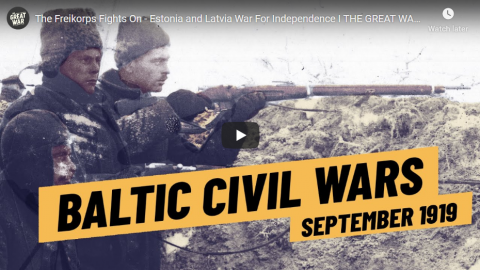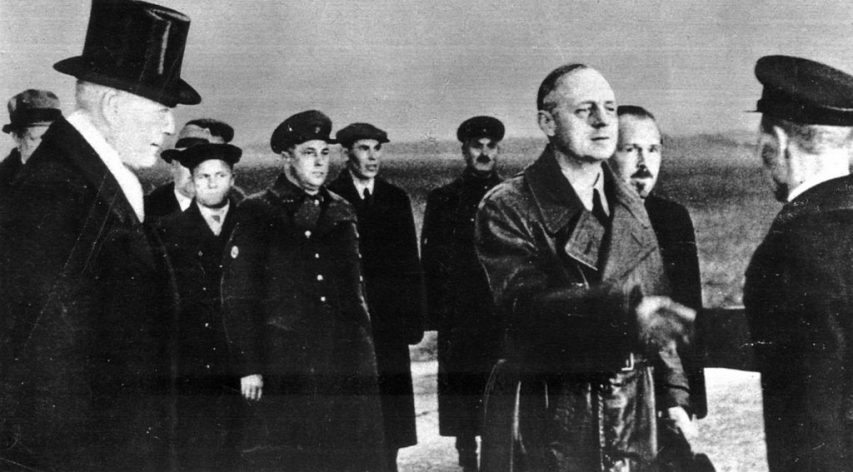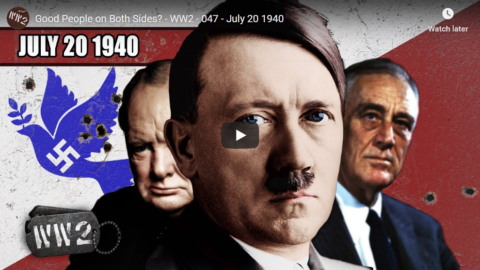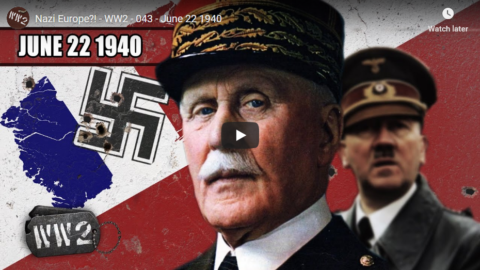The Great War
Published 27 Sep 2019Support 16 Days in Berlin: https://realtimehistory.net/indiegogo
After the Battle of Cesis it seemed the situation in Latvia and Estonia was about to quieten down. But the German soldiers in the region and the ongoing conflict with Bolshevik Russia meant the 2nd half of 1919 saw even more fighting in the Baltics.
» SUPPORT THE CHANNEL
Patreon: https://www.patreon.com/thegreatwar
Merchandise: https://shop.spreadshirt.de/thegreatwar/»CREDITS
Presented by: Jesse Alexander
Written by: Jesse Alexander
Director: Toni Steller & Florian Wittig
Director of Photography: Toni Steller
Sound: Toni Steller
Editing: Toni Steller
Mixing, Mastering & Sound Design: http://above-zero.com
Maps: Daniel Kogosov (https://www.patreon.com/Zalezsky)
Research by: Jesse Alexander
Fact checking: Florian WittigChannel Design: Alexander Clark
Original Logo: David van StepholdA Mediakraft Networks Original Channel
Contains licensed material by getty images
All rights reserved – Real Time History GmbH 2019
September 28, 2019
The Freikorps Fights On – Estonia and Latvia War For Independence I THE GREAT WAR 1919
August 26, 2019
Russia attempts to retroactively “normalize” the Molotov-Ribbentrop Pact
Just before the outbreak of World War II on the Polish-German frontier, the Soviet Union concluded a non-aggression pact with Hitler’s Germany that included a large slice of Polish territory and a free hand in the Baltic for Soviet expansion (only the early Finnish success prevented total Soviet domination of the eastern Baltic region). The current Russian government is conducting a public relations (propaganda) campaign to recast this pact as being unexceptional diplomatic activity by attempting to cast Britain, France, and all the other countries that had active diplomatic arrangements with Germany as being “just the same” as the infamous Molotov-Ribbentrop Pact. Wikipedia sums up the fate of the two chief diplomats:
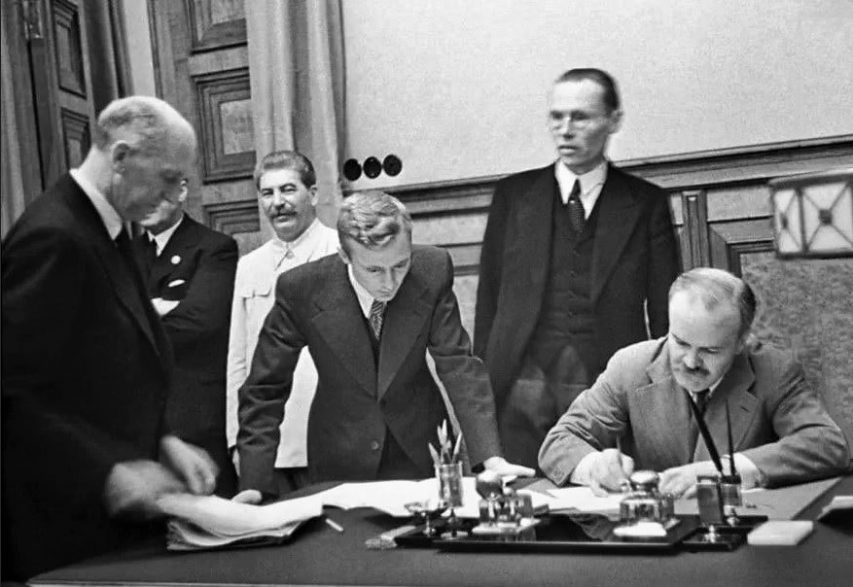
Translation of the Russian caption for this image:
People’s Commissar of Foreign Affairs of the USSR V.M. Molotov signs a friendship and border treaty between the USSR and Germany. Among those present: I.V. Stalin, translator of the Ministry of Foreign Affairs V.N. Pavlov, German diplomat G. Hilger (“truncated” version of the photograph of M. Kalashnikov distributed on the net)
Photograph attributed to Mikhail Mikhaylovich Kalashnikov (1906-1944) via Wikimedia Commons.
The Pact was terminated on 22 June 1941, when Nazi Germany launched Operation Barbarossa and invaded the Soviet Union (thus as well executing the ideological goal of Lebensraum). After the war, von Ribbentrop was convicted of war crimes and executed. Molotov died aged 96 in 1986, five years before the USSR’s dissolution. Soon after World War II, the German copy of the secret protocol was found in Nazi archives and published in the West, but the Soviet government denied its existence until 1989, when it was finally acknowledged and denounced. Vladimir Putin, while condemning the pact as “immoral”, has also defended the pact as a “necessary evil”, a U-turn following his earlier condemnation
Arthur Chrenkoff explains why we should vigorously resist this attempt to “normalize” Molotov-Ribbentrop:
1. While the shameful Western appeasement of Hitler, culminating in the infamy of Munich, allowed the Reich to bloodlessly dismember the sovereign and democratic Czechoslovakia, neither Great Britain nor France participated in or benefited from Germany’s cannibalism of this “faraway country of which we know little”. The difference is that while the West remains ashamed of Munich (a name which quickly become synonymous with a craven sell-out), a few years back, Russia’s culture minister Vladimir Medinsky called the Ribbentrop-Molotov pact “a great achievement of Soviet diplomacy”.
2. Unlike all the other agreements signed with Germany during the 1930s, it was the Ribbentrop-Molotov pact that green-lit the armed German aggression and led to the outbreak of the deadliest war in human history. It’s difficult to blame Germany’s neighbours or countries threatened by the Soviet Union (like Poland, Romania and the Baltic states) for trying to stay on Germany’s good side. It was naive and in any case it didn’t work in the end, as they all later found out to their detriment and downfall. Soviet Union, on the other hand, not only climbed into bed with Nazi Germany but it fully and enthusiastically consummated this marriage of convenience.
3. Unlike other agreements cited above, thanks to the “secret protocols” attached to the Ribbentrop-Molotov pact, the Soviet Union was both a co-aggressor in and a co-beneficiary of the start of World War Two. Stalin has relatively bloodlessly acquired the by-then (mid-September) almost defenseless eastern Poland (subsequently incorporated into Belarussian and Ukrainian Soviet Republics; these historically Polish areas remain today parts of Belarus and Ukraine), Bessarabia from Romania (incorporated into the Moldovan Soviet Republic), the Baltic States of Lithuania, Latvia and Estonia, as well as being given a free hand in the invasion of Finland, a country which otherwise might have counted on German friendship and support. All these aggressive territorial gains were the consequence of the Ribbentrop-Molotov division of Eastern Europe between the Reich and the Soviet Union into the respective spheres of interest, soon confirmed as the “facts on the ground” by Wehrmacht and Red Army.
4. While Britain and France, their empires and their allies, fought Germany for almost two years after September 1939, first through the period of the “phony war”, then through the Blitzkrieg in the West and the Battle of Britain, the Soviet Union remained a de facto Nazi ally, continuing to cooperate in security matters and supplying Germany with food and raw materials. Grain trains were still rolling west across the border with the Reich as Wehrmacht was launching Operation Barbarossa in the morning of 22 June 1941. During the period of Nazi-Soviet cooperation, Germany conquered Poland, Norway, Denmark, Belgium, the Netherlands, Luxembourg, France, Yugoslavia and Greece. Soviet exports helped to feed and build up the German war machine before it was unleashed against the West in 1940; German troops surging into the Low Countries walked on their stomachs (to borrow from Napoleon) full of bread baked from Russian wheat or were carried on the tanks and trucks made with Russian coal and ores. Never forget that for Russia, World War Two – or the Great Patriotic War as it is called there – begins only in June 1941, not September 1939, as it does in all Western history books.
5. It’s true that the Ribbentrop-Molotov pact was partly defensive in nature as far as the Soviet Union was concerned, aiming to postpone the inevitable armed clash between the two rival totalitarianisms and in the meantime give Russia some essential breathing space to build up its army and strategic reserves (the top leadership of the Soviet armed forces was decapitated by Stalin during the purges in 1937-8, leaving them even more unprepared to face Germany than would have otherwise been the case). But as I pointed out above, it was also offensive and directly benefited Stalin’s territorial ambitions while it lasted. In some ways, the legacy of the pact lives on in the shape of Poland’s post-war borders, which have nothing to do with its thousand-year history. This is the real #TruthAboutWWII and this is why the Ribbentrop-Molotov pact remains singled out in the infamy of the interwar European democracy.
July 21, 2019
Good People on Both Sides? – WW2 – 047 – July 20 1940
World War Two
Published on 20 Jul 2019Peace seems to slowly return to the European mainland, but not for long, as the Germans move their airplanes to the French coast to Battle Britain in the skies while they make invasion plans, and the Soviets are entering the Baltics after ‘elections’ invited them to.
Join us on Patreon: https://www.patreon.com/TimeGhostHistory
Or join The TimeGhost Army directly at: https://timeghost.tvFollow WW2 day by day on Instagram @World_war_two_realtime https://www.instagram.com/world_war_t…
Join our Discord Server: https://discord.gg/D6D2aYN.
Between 2 Wars: https://www.youtube.com/playlist?list…
Source list: http://bit.ly/WW2sourcesWritten and Hosted by: Indy Neidell
Produced and Directed by: Spartacus Olsson and Astrid Deinhard
Executive Producers: Bodo Rittenauer, Astrid Deinhard, Indy Neidell, Spartacus Olsson
Creative Producer: Joram Appel
Post production director:Wieke Kapteijns
Research by: Indy Neidell
Edited by: Marek Kaminski
Map animations: EastoryColorisations by Norman Stewart and Julius Jääskeläinen https://www.facebook.com/JJcolorization/
Eastory’s channel: https://www.youtube.com/channel/UCEly…
Archive by Screenocean/Reuters https://www.screenocean.com.A TimeGhost chronological documentary produced by OnLion Entertainment GmbH.
June 23, 2019
Nazi Europe?! – WW2 – 043 – June 22 1940
World War Two
Published on 22 Jun 2019While the fighting subsides in much of France, the Italians invade in the south, while tension continues to grow in the Baltic states as the Red Army increases its presence and the USSR makes plans for coups.
Join us on Patreon: https://www.patreon.com/TimeGhostHistory
Or join The TimeGhost Army directly at: https://timeghost.tvFollow WW2 day by day on Instagram @World_war_two_realtime https://www.instagram.com/world_war_t…
Join our Discord Server: https://discord.gg/D6D2aYN.
Between 2 Wars: https://www.youtube.com/playlist?list…
Source list: http://bit.ly/WW2sourcesWritten and Hosted by: Indy Neidell
Produced and Directed by: Spartacus Olsson and Astrid Deinhard
Executive Producers: Bodo Rittenauer, Astrid Deinhard, Indy Neidell, Spartacus Olsson
Creative Producer: Joram Appel
Post-Production Director: Wieke Kapteijns
Research by: Indy Neidell
Edited by: Daniel Weiss
Map animations: EastoryColorisations by:
– Julius Jääskeläinen, https://www.facebook.com/JJcolorization/ – Norman Stewart, https://www.patreon.com/89tavernEastory’s channel: https://www.youtube.com/channel/UCEly…
Archive by Screenocean/Reuters https://www.screenocean.com.Sources :IWM (F 4871), IWM_HU 76027, Bundesarchiv, Photos from the Jonatan Myhre Barlien photo collection.
A TimeGhost chronological documentary produced by OnLion Entertainment GmbH.
From the comments:
World War Two
2 days ago
After 44 days of fighting, the Battle of France seems to come to an end. For the Germans at least. For the French, the war goes on with Italy. And for us, it goes on as well. These were one of the most exciting videos for us to produce so far. We tried to take the videos to the next level with more and better maps (shoutout to Eastory: everyone who reads this should subscribe to his channel: ) and more animations. In general, we aim to constantly increase our production quality, which we humbly think is succeeding bit by bit. However, this wouldn’t be possible if it wasn’t for the support of those who financially aid us on http://www.patreon.com/timeghosthistory or on our own website https://timeghost.tv. Without them, we wouldn’t be doing any of this. If you like what we’re doing, please consider supporting us as well!Cheers,
Joram
June 16, 2019
Britain Votes to Leave – WW2 – 042 – June 15 1940
World War Two
Published on 15 Jun 2019The fighting in France isn’t over, not even when Paris falls, as the Germans advance and Italy joins the fight. But the Brits now have their back to yet another ocean and see no option but out. Further east Stalin uses the chaos in the West as cover to start moving in on his neighbours.
Join us on Patreon: https://www.patreon.com/TimeGhostHistory
Or join The TimeGhost Army directly at: https://timeghost.tvFollow WW2 day by day on Instagram @World_war_two_realtime https://www.instagram.com/world_war_t…
Join our Discord Server: https://discord.gg/D6D2aYN.
Between 2 Wars: https://www.youtube.com/playlist?list…
Source list: http://bit.ly/WW2sourcesWritten and Hosted by: Indy Neidell
Produced and Directed by: Spartacus Olsson and Astrid Deinhard
Executive Producers: Bodo Rittenauer, Astrid Deinhard, Indy Neidell, Spartacus Olsson
Creative Producer: Joram Appel
Research by: Indy Neidell
Post Production Director: Wieke Kapteijns
Edited by: Marek Kamiński
Map animations: EastoryColorisations by Norman Stewart and Julius Jääskeläinen https://www.facebook.com/JJcolorization/
Eastory’s channel: https://www.youtube.com/channel/UCEly…
Archive by Screenocean/Reuters https://www.screenocean.com.Sources: Italo-Scottish Research Cluster, Alchemist-hp
A TimeGhost chronological documentary produced by OnLion Entertainment GmbH.
From the comments:
World War Two
2 days ago
Paris… German soldiers in 1914 left their homes for the western front painted “To Paris” on their train carriages, little did they know what horrors were awaiting them. And that after four years of fighting in the trenches, none of them made it to Paris. This week, after another month of fighting in France, they finally do.Whenever we read that some of you think that it’s just Indy making all of this, we have a good laugh. Actually, there are over 10 people working on this project. We have multiple editors, researchers/historians, producers, fact-checkers, colorisers and volunteers working on this. And of course there’s Eastory making the maps. We’d like to pay each and everyone of them for their hard work so they can feed themselves. Truth is, many of them work on a voluntary or part-time basis right now. The support we get on Patreon and our website is great and helps us sustain this channel, but we’re not nearly at the point that everyone involved gets what they deserve. If you like our work here on YouTube and you want to support the people who make it, please check us out on https://www.patreon.com/TimeGhostHistory or on our website https://timeghost.tv. Help us make history! Every dollar counts!
Cheers,
Joram
January 11, 2019
Poland Rises in the East I BETWEEN 2 WARS I 1921 Part 2 of 2
TimeGhost History
Published on 10 Jan 2019In 1921 the Second Polish Republic expands to the borders it will have until it is overrun by the Germans and Soviets in September of 1939. Through conquest, popular uprisings, plebiscite, and the Treaty of Versailles Poland incorporates land from her neighboring nations.
Join us on Patreon: https://www.patreon.com/TimeGhostHistory
Hosted by: Indy Neidell
Written and directed by: Spartacus Olsson
Produced by: Astrid Deinhard
Executive Producers: Bodo Rittenauer, Astrid Deinhard, Indy Neidell, Spartacus Olsson
Edited by Wieke Kapteijns
Research by: Kamil SzadkowskiVideo Archive by Screenocean/Reuters http://www.screenocean.com
A TimeGhost chronological documentary produced by OnLion Entertainment GmbH
September 30, 2018
Poland is Crushed – WW2 – 005 29 September 1939
World War Two
Published on 29 Sep 2018Facing two enemies at once, Poland finds itself in a crushing vice after less than a month of war and the Polish forces must flee their own country to live to fight another day.
Join us on Patreon: https://www.patreon.com/TimeGhostHistory
Or join The TimeGhost Army directly at: https://timeghost.tvWritten and Hosted by: Indy Neidell
Produced and Directed by: Spartacus Olsson and Astrid Deinhard
Executive Producers: Bodo Rittenauer, Astrid Deinhard, Indy Neidell, Spartacus Olsson
Research by: Indy Neidell
Edited by: Spartacus Olsson
Trainee Editors: Sarvesh and Ben Ollerenshaw
Colorized Pictures by Spartacus OlssonArchive by Screenocean/Reuters http://www.screenocean.com
A TimeGhost chronological documentary produced by OnLion Entertainment GmbH
August 28, 2017
Great Northern War – II: A Good Plan – Extra History
Published on 26 Aug 2017
The wrath of Charles XII was now aimed directly at Poland-Lithuania. But their leader had a plan! ..A terrible plan.
Augustus the Strong was determined to prove his might by defeated Charles XII on the battlefield. He gathered his Polish-Lithuanian forces, met the Swedes, and proceded to… lose. And lose. And lose. Then he got deposed and started a civil war which of course he also lost.
August 25, 2017
Great Northern War – I: When Sweden Ruled the World – Extra History
Published on 19 Aug 2017
A young boy king had inherited the crown of the Swedish Empire, and his neighbors saw an opportunity to attack. To their surprise, young Charles XII of Sweden turned out to be a fearsome opponent who quickly repelled their assaults – and then sought revenge.
August 8, 2017
The Baltic States in World War 1 I THE GREAT WAR SPECIAL
Published on 7 Aug 2017
Before the First World War, what are today Lithuania, Latvia, and Estonia were part of the Russian Empire. As that empire fought and fell, so to fought the soldiers of the Baltic States, first during the war, and then in their struggles for eventual independence.
April 13, 2016
The bureaucracy will always be with us
Strategy Page recounts some of the recent the bureaucratic snags between NATO countries in eastern Europe when troops need to cross inter-alliance borders:
In early 2015 Operation Dragoon Ride rolled through Central Europe to send a message to Russians. From March 20th to April 1st, an US Army squadron returning from Atlantic Resolve NATO exercises took an unusual route back to its base in Germany, after spending three months in training facilities in Poland, Lithuania and Estonia. The unit involved was the 3rd Squadron (battalion) of the 2nd American Cavalry Regiment. This unit refers to itself as dragoons (an ancient term for horse mounted infantry) and the movement operation was called Dragoon Ride and the apparent reason for it was to demonstrate to the locals as well as the Russians that American armored units could reach the East European NATO nations by road, as well as by ship, aircraft or rail. Dragoon Ride purposely rode close to the Russian border, often in full view of Russians and Russian media. The American troops frequently stopped in towns and villages so the locals could meet their allies, take pictures and quietly enjoy the pain this demonstration was causing the increasingly aggressive Russians.
But what was not publicized, and what the Russian government knew full well, was that this road movement took the efforts of hundreds of unseen troops and bureaucrats to deal with the paperwork. For all of 2015 it required nearly 6,000 travel documents to be prepared, filed and approved to get foreign military vehicles across East European borders. Some of these documents take several weeks to get approved and operations like Dragoon Ride required hundreds of them and nearly as many NATO local government personnel were involved with this paperwork as were actually participating (500 troops) in the actual Dragoon Ride (of 120 vehicles). While all these rules and approvals would not stop invading Russians they would, in theory, slow down reinforces from the West.
The pile of paperwork and weeks required to handle it were used as very concrete evidence to persuade the East European nations to streamline the process, a lot, or have themselves to blame if reinforcements did not arrive in a timely fashion. As usual a compromise was worked out. Thus eight NFIUs (NATO Force Integration Units) were organized, each consisting of 40 troops trained and equipped to handle the paperwork and traffic control measures required to get military convoys across eastern borders as quickly as possible. The NFIU work out of embassies and stay in constant touch with the border control bureaucracies of the East European nations involved. NFIUs also arrange for rest areas and resupply for the convoys.
November 30, 2015
Why Don’t You Use Modern Names For Cities? Who Was A Capable Commander in WW1? I OUT OF THE TRENCHES
Published on 28 Nov 2015
Indy sits in the chair of wisdom again and this time answers two questions that you were asking a lot. He explains his policy for naming places in a historical context and if there were any good commanders actually.
September 25, 2015
The German Occupation of Lithuania – Unrest in Russia I THE GREAT WAR – Week 61
Published on 24 Sep 2015
When the Germans take Vilnius, they set their plans of “germanizing” the whole area into motion. Erich Ludendorff believes that Courland and other areas near East Prussia are culturally German and that he’s returning them to the Fatherland. While the Russian Army is now in a much better defensive position after their Great Retreat, civil unrest across the country is becoming a problem. Huge losses and the difficult supply situation are making it difficult to maintain order. At the same time, Bulgaria is mobilizing her troops, foreshadowing yet another front in this World War.
February 25, 2015
How worried are Russia’s neighbours? Lithuania just re-introduced conscription
A report from the Lithuania Tribune details a change in Lithuanian defence policy:
The State Defence Council, comprising of the Lithuanian president, prime minister, parliament speaker, defence minister and army chief, decided on Tuesday to reintroduce military conscription in Lithuania.
The conscription, which was suspended several years ago as Lithuania opted for the professional army, should be reintroduced in light of the changes in geopolitical situation, President Dalia Grybauskaitė said after the meeting.
“We must reinforce the country’s defence capacities. Under new geopolitical circumstances, the army must be properly prepared for the country’s armed defence even in times of peace. Today’s geopolitical situation requires that we strengthen and speed up the manning of our army. Therefore the State Defence Council has decided that it is necessary to temporarily, for five years, reintroduce compulsory military draft,” President Grybauskaitė said.
Under the proposal, compulsory military service would apply to men between the ages of 19 and 26. The plan is to draft between 3,000 and 3,500 men each year. Exemptions would apply to university students, single fathers, men with health issues or otherwise unsuitable for military service.
In Newsweek, Damien Sharkov reports on the high tempo of Russian “training” missions near the Baltic states:
Increasingly frequent snap military drills being carried out by Russia near its eastern European neighbours could be part of a strategy that will open the door for a Russian offensive on the Baltic states according to defence expert Martin Hurt, deputy director at Estonia’s International Centre for Defence and Security.
The Lithuanian and Estonian defence ministries have expressed alarm at the increased military activity, and drawn comparisons with moves prior to the Russian invasion of Crimea.
Commenting on Russia’s announcement last week that its armed forces will not cease holding snap military exercises, Hurt, who has previously worked for Estonia’s Ministry of Defence as well as for the armed forces of both Estonia and Sweden, warned against taking this news lightly.
“My take would be that the Russian authorities want to raise the readiness of their forces and also make European nations more relaxed to a new norm where the Russian Armed Force often conduct snap exercises,” Hurt says.
According to him, a relaxed European attitude about increased Russian military activity would be “extremely dangerous” for the democratic governments of Europe and particularly for Estonia, Latvia and Lithuania.
“A realistic scenario against the Baltics would be a ‘normal’ Russian snap exercise that without notice turns into a quick assault on one or several of the Baltic states’ capitals. Such an attack would have greater probability of success than the hybrid scenario we saw in Crimea,” Hurt adds.
“A decisive move by Putin assuming that the weak leaders of Europe will not react quickly and ‘avoid escalation’ is a possible scenario,” Hurt adds, highlighting that “the higher readiness NATO forces have, the better it is for the democratic part of Europe.”
July 21, 2014
QotD: Algis Budrys on Hitler’s impact on audiences
Algirdas Jonas Budrys was born in 1931 in Lithuania, but he didn’t stay there long. His father was an official in Lithuania’s diplomatic corps and while A J was still small the family was posted to Konigsberg in the German province of East Prussia. A J, who had just about got a good handle on the Lithuanian language, began to learn German. His adult memories of East Prussia — which, like the rest of Germany, had been Nazified with the accession of Adolf Hitler a few years earlier — were troublesome.
He particularly recalled Hitler himself parading right past the Budrys apartment when he was five, he told Mark Williams in an interview shortly before he died. “After the Hitlerjugend walked through, Hitler came by in an open black Mercedes with his arm propped up.” The crowds made “indescribable” sounds. Men lost control of their bowels and had to race for the bushes or writhed and rolled on the ground.
Fred Pohl, “A J”, The Way The Future Blogs, 2010-07-26

